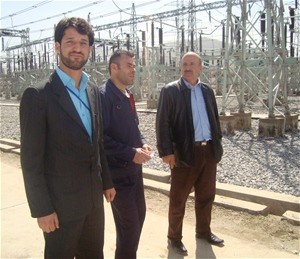
Ghulam Jailani, far right, is the manager of Kabul’s Chimtala Substation, the newest and largest in Afghanistan. The substation provides 60 to 70 percent of electricity to Kabul. Chimtala was already connected to the VSAT communications network when the s
USAID/AIRP
USAID supports reliable VSAT communication between power substations.
13 JUNE 2010 | KABUL, AFGHANISTAN
As more people in Afghanistan gain access to government-provided electricity, USAID is helping to create an effective and reliable electrical grid to deliver power. Electricity in Afghanistan is distributed by substations operated by Da Afghanistan Breshna Sherkat, the country’s electricity company. To regulate the voltage that flows through power lines, the substations need to communicate with each other regarding power flow and unexpected issues.
Before 2009, substations in the North East Power System communicated by using an assortment of unmatched radios and frequencies. This approach created many problems. Some of the substations are located at great distances from each other while mountains surround others, hampering coverage. Electro-magnetic fields generated by the stations themselves also interfered with reliable communication.
To correct the situation, USAID’s Afghanistan Infrastructure Rehabilitation Program (AIRP) connected each substation to a system of telephones connected to small satellite dishes known as very small aperture terminals (VSATs). The network established reliable uninterrupted communications among the stations for the first time. Kabul’s Chimtala Substation, the newest and largest in Afghanistan, was already linked to the VSAT system when it came on line last year.
Ghulam Jailani is the manager of Chimtala and considers the VSAT network essential to the substation’s operations. He and his all-Afghan staff of 12 oversee the supply of 60 to 70 percent of the electricity in Kabul. “Without communications, we can’t do anything,” Mr. Jailani said. “If suddenly there is a shutdown somewhere, this is a very bad case.”
Presently, Chimtala is capable of generating 320 megawatts (MW) of power, and is expected to grow to 500 MW in a few years. Mr. Jailani believes that the station and its effective communications network is critical to the growth and development of Kabul.
Moe Aslam, the manager of the USAID/AIRP project to help centralize energy operations, agrees. “These and other improvements to power delivery will help bring Afghanistan up to date in the energy sector,” he said. “Our program will standardize the whole system.”







Comment
Make a general inquiry or suggest an improvement.